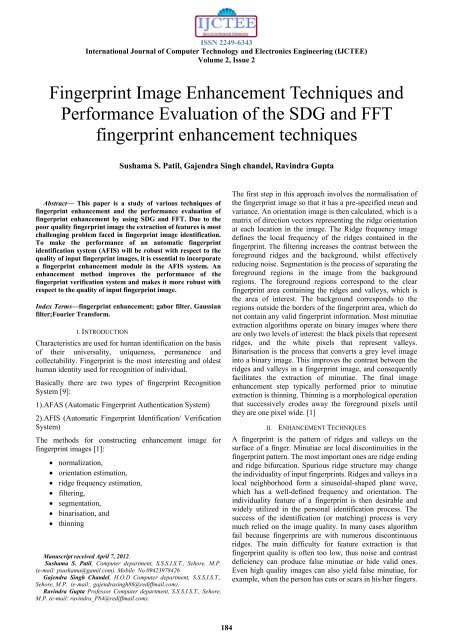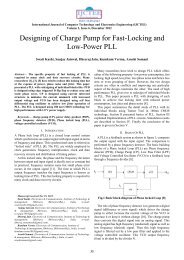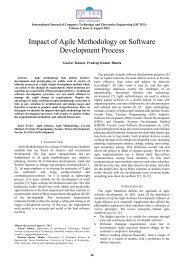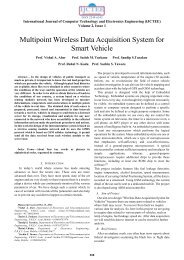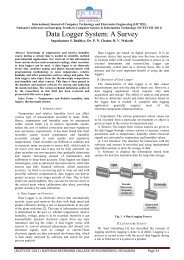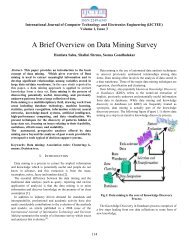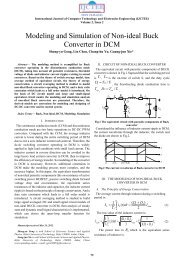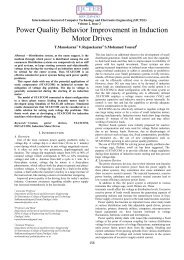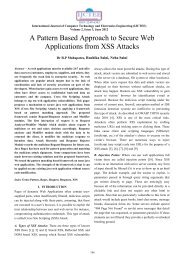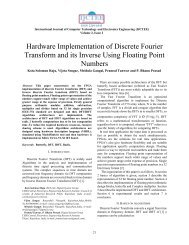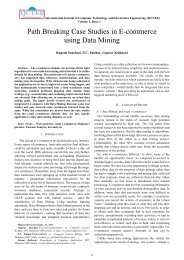Fingerprint Image Enhancement Techniques and Performance ...
Fingerprint Image Enhancement Techniques and Performance ...
Fingerprint Image Enhancement Techniques and Performance ...
You also want an ePaper? Increase the reach of your titles
YUMPU automatically turns print PDFs into web optimized ePapers that Google loves.
ISSN 2249-6343International Journal of Computer Technology <strong>and</strong> Electronics Engineering (IJCTEE)Volume 2, Issue 2where n <strong>and</strong> n⊥ are mutually normal unit vectors, <strong>and</strong> n is inparallel with the ridge direction. The shape of the kernel iscontrolled through σ 1 2 (x 0 ) <strong>and</strong> σ 2 2 (x 0 ), ρ satisfy the conditionρ( x ) = 1 when | x| < r, <strong>and</strong> r is the maximum support radius.The modified filter to a b<strong>and</strong> pass filter in order to adapt it to afingerprint image [8]:when a ridgeline edge is encountered the kernel isdeformed into an ellipse with a major axis aligned in parallelwith the edge (Fig. 3). Therefore, smoothing is performedalong but not across the ridgeline.Figure 4: Filtered images <strong>and</strong> their corresponding featurevectors for orientations 0 O , 22.5 O , <strong>and</strong> 45 O are shown.E. Fast Fourier TransformIn this method the image is divided into small processingblocks (32 x 32 pixels) <strong>and</strong> perform the Fourier transformaccording to equation:Figure 3 Controlling the shape of anisotropic filter.D. Gabor FilterGabor filters optimally capture both local orientation <strong>and</strong>frequency information from a fingerprint image. By tuning aGabor filter [3] to specific frequency <strong>and</strong> direction, the localfrequency <strong>and</strong> orientation information can be obtained asshown in Figure 4.An even symmetric Gabor filter has the following generalform in the spatial domain:Wherewhere f is the frequency of the sinusoidal plane wave alongthe direction θ from the x-axis, <strong>and</strong> δx <strong>and</strong> δy are thespace constants of the Gaussian envelope along x <strong>and</strong> y axes,respectively.The filtering is performed in the spatial domain with a masksize of 17x17. The frequency f is the average ridge frequency(1/K), where K is the average inter ridge distance. Theaverage inter ridge distance is approximately 10 pixels in a500 dpi fingerprint image. Hence, f = 1/10. Sixteen differentorientations are examined. These correspond to θ values of0, 11.25, 22.5, 33.75, 45, 56.25, 67.5, 78.75, 90, 101.25,112.5, 123.75, 135, 146.25, 157.5 <strong>and</strong> 168.75 degrees. Thevalues for δx' <strong>and</strong> δy' were empirically determined <strong>and</strong>each is set to 4 (about half the average inter ridge distance).(7)for u = 0, 1, 2, ..., 31 <strong>and</strong> v = 0, 1, 2, ..., 31.In order to enhance a specific block by its dominantfrequencies, we multiply the FFT of the block by itsmagnitude a set of times. Where the magnitude of the originalFFT = abs (F (u, v)) = |F (u, v)|.So we get the enhanced block according to the equation:where F-1(F (u, v)) is given by:For x = 0, 1, 2 …31 <strong>and</strong> y = 0, 1, 2 ...31.The k in formula (8) is an experimentally determinedconstant, which we choose k=0.45 to calculate. A highvalue of k improves the appearance of the ridges byfilling up small holes in ridges, but too high value of kcan result in false joining of ridges which might lead toa termination become a bifurcation.Figure 5(a) Enhanced <strong>Image</strong> after FFT, (b) <strong>Image</strong> before FFT(8)(9)186
ISSN 2249-6343International Journal of Computer Technology <strong>and</strong> Electronics Engineering (IJCTEE)Volume 2, Issue 2The enhanced image after FFT has the improvements assome falsely broken points on ridges get connected <strong>and</strong>some spurious connections between ridges getremoved.F. Short time Fourier Transform (STFT)During STFT [4] analysis, the image is divided intooverlapping windows. It is assumed that the image isstationary within this small window <strong>and</strong> can be modeledapproximately as a surface wave. The Fourier spectrum ofthis small region is analyzed <strong>and</strong> probabilistic estimates ofthe ridge frequency <strong>and</strong> ridge orientation are obtained. TheSTFT analysis also yields an energy map that may be used asa region mask to distinguish between the fingerprint <strong>and</strong> thebackground regions. The orientation image is then used tocompute the angular coherence. The coherence image is usedto adapt the angular b<strong>and</strong>width. The resulting contextualinformation is used to filter each window in the Fourierdomain. The enhanced image is obtained by tiling the resultof each analysis window.Short Time Fourier analysis: To resolve the properties of theimage both in space <strong>and</strong> also in frequency it uses twodimensional image signals to perform short(time/space)-frequency analysis. [4]When analyzing a non-stationary 1D signal x(t) it isassumed that it is approximately stationary in the span of atemporal window w(t) with finite support. The STFT of x(t) isnow represented by time frequency atoms X(T,w) is given by,Wavelet transform is suited for the analysis of transient <strong>and</strong>time varying signals. In two dimensions, a scaling functionφ(x, y) , <strong>and</strong> three directional wavelets ψ H (x,y), ψ V (x, y) <strong>and</strong>ψ D (x, y) are necessary. Each scaling function or wavelet isthe product of the one dimensional scaling function φ <strong>and</strong>corresponding wavelet ψ. The four two-dimensional productsproduce the scaling function (13) <strong>and</strong> separable directionalsensitive wavelets (14), (15) <strong>and</strong> (16).φ(x,y) = φ(x)φ(y) (13)ψ H (x,y) = ψ(x) φ(y) (14)ψ V (x, y) = φ(x)ψ(y) (15)ψ D (x, y) = ψ(x)ψ(y) (16)These wavelets measure the gray level variations for imagesalong three directions, where ψ H (x,y) measures variationsalong columns (horizontal), ψ V (x,y) responds to variationsalong rows (vertical) <strong>and</strong> ψ D (x,y) corresponds to variationsalong diagonals.In a two dimensional discrete wavelet transform, the scaled<strong>and</strong> translated basis functions are defined by:(17)In the case of 2D signals such as a fingerprint image, thespace-frequency atoms is given by,i = {H, V, D}where index i identifies the directional wavelets according toequation (11), (12) <strong>and</strong> (13). The discrete wavelet transformof function f (x,y) of size M X N is formulated as:Here T 1 , T 2 represent the spatial position of the twodimensional window W(x,y). w1, w2 represents the spatialfrequency parameters. A local region of the image can bemodeled as a surface wave according toIII. DIRECTIONAL WAVELET TREANFORMIn the fingerprint image, the pattern is related to the ridgedirection. In principle, the enhancement can help visualizingthe ridges. A directional wavelet transform is applied todecompose the image into its orientation representation.Directional filtering is applied to each direction before imagereconstruction. This is shown in Fig. 5 below.i= {H,V,D}where i={H,V,D} , j 0 is the starting scale, the Wφ( j 0 ,m,n)coefficients define the approximation of f (x,y) , at scale j 0 .The Wψ( j,m,n) coefficients represent the horizontal, vertical<strong>and</strong> diagonal details for scales j >= j 0 . Here j 0 = 0 <strong>and</strong> selectM +N = 2 J so that j = 0,1,2,.., J- m, n = 0,1,2,..,(2 J -1).Then f (x,y) is obtained via the inverse discrete wavelettransform.Figure 6: <strong>Fingerprint</strong> enhancement by mean of wavelettransform <strong>and</strong> directional filteringNow the wavelets are defined by both the scaling functionφ(x,y) (Father Wavelet) <strong>and</strong> wavelet functions ψ(x,y) (motherwavelet) in the discrete time domain. The wavelet functionacts as a b<strong>and</strong>pass filter whose b<strong>and</strong>width is reduced to halfafter each scaling.187
ISSN 2249-6343International Journal of Computer Technology <strong>and</strong> Electronics Engineering (IJCTEE)Volume 2, Issue 2IV. DYADIC SCALE-SPACEHere first decompose the fingerprint image into a seriesof images at different scales, then analyze <strong>and</strong> organizewhole characters <strong>and</strong> details, at last combine the creditableinformation to enhance the fingerprint image.Scale-space theory provided a canonical framework formodeling visual operations at multiple scales. Thescale-space representation L: R 2 xR→R of a two-dimensionalimage f is defined as the one-parameter family of functionsobtained by convolving f with Gaussian kernel:Where<strong>and</strong> the parameter t is called scale parameter. is thedirection of the pixel (x, y). Although fingerprint images arenon-isotropic, we use the linear scale-space to detect thefeature because in local region, the ridge is a line. And theconvolution is along the ridge direction, as we adapt the filterto ridge direction.In scale-space, with the increase of the scale, the number ofthe details decreases <strong>and</strong> the noise is successively suppressedgradually. The feature of the image in large scale exists in theimage of small scale, while weak signal will disappear in thelarge scale space. Those existing in the image of large scaleare global structure.Using a series of scaleto filter the image f, note the scale-space representation as L , k = 1; 2; . . ,nwith scale . We define the details between two scales asfollowing:Taken σ x =σ y the second derivative of Gaussian filter given ineqn. (18) is the straightforward extension of the Gaussianfirst derivative filter [16].For fingerprint images, this second derivative filter canenhance the ridge <strong>and</strong> suppress the valley for certain degree.To enhance the effectiveness of the filter or to make it moredirectional sensitive, the filter itself can be modified slightlyby cooperating the cosine function (or plan wave) as follow:(23)Where φ, σ φ ,x φ ,y φ <strong>and</strong> f are defined as those of Gabor filter.The filter’s appearance is shown in Fig. 6d. Compared to thewell-known Gabor filter of which the appearance shown inFig. 6c, the modified second derivative filter offers the verysimilar shape. In fact they are variations of each other.Figure 7: appearance of filters: (a) Gaussian filter, (b) Secondderivative of Gaussian filter, (c) Gabor filter, <strong>and</strong> (d) modifiedLet:When we get the scale-space representation <strong>and</strong> itsdetails, construct the image f :We get the smoothed image of the fingerprint image fusing dyadic scale-space:where k=1,2,……,n 0V. SECOND DERIVATIVE GAUSSIAN FILTERA 2D Gaussian filtering is widely used in the area of imageprocessing. Generally it performs low pass filtering. Its plot isshown in Fig. 6(a). However, for directive filtering a plancosine wave can be multiplied to the Gaussian function. Itsfirst <strong>and</strong> second derivatives are also widely used. Forexample, the line detection technique proposed by [11]. Itappears in several slight different forms. However, the onewe are interesting is taken from [12]. Its appearance is shownin Fig. 6b. Gabor filter is another well known filter infingerprint enhancement. Its appearance is shown in Fig. 6c.The 2D circular Gaussian filter (σ x = σ y ) is mostly adopted asan image preprocessing step for image smoothing <strong>and</strong>denoising, while the 2D elliptical Gaussian filter can be usedfor enhancement of lines since σ x <strong>and</strong> σ y can be separatelyspecified. The filter function issecond derivative of Gaussian filterVI. PERFORMANCE EVALUATION INDEXTwo indexes are well accepted to determine the performanceof a fingerprint recognition system:False Rejection Rate (FRR): For an image database, eachsample is matched against the remaining samples of the samefinger to compute the False Rejection Rate188
ISSN 2249-6343International Journal of Computer Technology <strong>and</strong> Electronics Engineering (IJCTEE)Volume 2, Issue 2False Acceptance Rate (FAR): Also the first sample of eachfinger in the database is matched against the first sample ofthe remaining fingers to compute the False Acceptance Rate.evaluate the computing efficiency for the two enhancementtechniques are Second Derivative of Gaussian Filter <strong>and</strong> FastFourier Transformation, <strong>and</strong> use the statistical method tocompare with performances of extraction minutiae. Theresult shows the better performance for the fingerprintenhancement is Second Derivative Of Gaussian Filter. All theexperiments are performed in a Intel core I5 2.30GHz PC.We use databases of FVC2004.ACKNOWLEDGMENTThe authors would like to thanks Raymond Thai forproviding a useful report on fingerprint image enhancement.Also I would be very thankful to Shlomo Greenberg, MayerAladjem, Daniel Kogan <strong>and</strong> Itshak Dimitrov, KeokanlayaSihalath, Somsak Choomchuay, Shatoshi Wada, JiangangCheng, Jie Tian, <strong>and</strong> Kazuhiko Hamamoto for their studypapers regarding fingerprint image enhancement. Also theauthor would like to welcome any comments <strong>and</strong> suggestionsfrom the anonymous reviewers.Table 1 False Rejection Rate of <strong>Fingerprint</strong> template matchingusing SDG <strong>and</strong> FFTTable 2 False Acceptance Rate of <strong>Fingerprint</strong> templatematching using SDG <strong>and</strong> FFTVII. CONCLUSIONSA lot of work has been done in the area of fingerprint imageenhancement. But despite the existence of numerouscommercial fingerprint image identification/recognitionsystems there are still important challenges for furtherresearch.The problems such as wet, dry <strong>and</strong> normal conditions offingers, pressure of finger over the device are of significantimportance. This paper provides a recent advances infingerprint image enhancement techniques to improve therobustness of fingerprint image enhancement to change infinger position, finger condition <strong>and</strong> finger pressure. In thispaper, in order to explain various enhancements method, weREFERENCES[1] RaymondThai, “<strong>Fingerprint</strong> <strong>Image</strong> <strong>Enhancement</strong> <strong>and</strong> MinutiaeExtraction” 2003[2] Shlomo Greenberg, Mayer Aladjem, Daniel Kogan <strong>and</strong> ItshakDimitrov, “<strong>Fingerprint</strong> <strong>Image</strong> <strong>Enhancement</strong> using Filtering<strong>Techniques</strong>” .[3] Muhammad Umer Munir <strong>and</strong> Muhammad Younas Javed “<strong>Fingerprint</strong>Matching using Gabor Filters” .[4] Sharat Chikkerur, Alex<strong>and</strong>er N.Cartwright, Venu Govindaraju,“<strong>Fingerprint</strong> <strong>Enhancement</strong> Using STFT Analysis” preprintedsubmitted to Elsevier Science 2May 2006.[5] Keokanlaya Sihalath, Somsak Choomchuay, Shatoshi Wada, <strong>and</strong>Kazuhiko Hamamoto “<strong>Fingerprint</strong> <strong>Image</strong> <strong>Enhancement</strong> with SecondDerivative Gaussian Filter <strong>and</strong> Directional Wavelet Transform” 2010Second International Conference on Computer Engineering <strong>and</strong>Application .[6] Somsak Choomchuay, Keokanlaya Sihalath, “An Application ofSecond Derivative of Gaussian Filters in <strong>Fingerprint</strong> <strong>Image</strong><strong>Enhancement</strong>”, 978-1-4244-4713-8/ 2010 IEEE.[7] G.Z Yang, P. Burger, D.N. Firmin, <strong>and</strong> S.R. Underwood, “Structureadaptive anisotropic image filtering,” <strong>Image</strong> <strong>and</strong> Vision Computing,no.14, pp.135-145, 1996.[8] S. Greenberg, “Adaptive anisotropic filter applied for <strong>Fingerprint</strong>enhancement,” submited for publication, 1999[9] A. K. Jain, S. Prabhakar <strong>and</strong> L. Hong, "A Multichannel Approach to<strong>Fingerprint</strong> Classification", IEEE Transactions on PAMI, Vol.21,No.4, pp. 348-359, April 1999.[10] A. Ross, A. K. Jain, <strong>and</strong> J. Reisman, "A Hybrid <strong>Fingerprint</strong> Matcher",Pattern Recognition, Vol. 36, No. 7, pp. 1661-1673, 2003.[11] Q. Li, L. Zhang, J. You, D. Zhang, <strong>and</strong> P. Bhattacharya,”Dark LineDetection with Line Width Extraction,” Proc. of ICIP2008, pp.621-624.[12] F. Yue, W.Zuo, K.Wang, <strong>and</strong> D. Zhang, “A <strong>Performance</strong> Evaluation ofFilter Design <strong>and</strong> Coding Schemes for Palmprint Recognition,” Proc.Of ICPR 2008.[13] Somsak Choomchuay, Keokanlaya Sihalath, “An Application ofSecond Derivative of Gaussian Filters in <strong>Fingerprint</strong> <strong>Image</strong><strong>Enhancement</strong>:[14] Greenberg, S., Aladjem, M., Kogan, D. & Dimitrov, I. (2000)<strong>Fingerprint</strong> <strong>Image</strong> <strong>Enhancement</strong> using Filtering <strong>Techniques</strong>. 15thInternational Conference on pattern Recognition, Barcelona, vol. III,pp. 326–329.[15] Jiangang Cheng, Jie Tian, “<strong>Fingerprint</strong> enhancement with dyadicscale-space” , Pattern Recognition Letters 25 (2004) 1273–1284189
ISSN 2249-6343International Journal of Computer Technology <strong>and</strong> Electronics Engineering (IJCTEE)Volume 2, Issue 2[16] D. Mario <strong>and</strong> D. Maltoni, “Direct Gray-Scale Minutiae Detection In<strong>Fingerprint</strong>s,” IEEE Trans. Pattern Analysis <strong>and</strong> Machine Intelligence,vol. 19, no. 1, pp.27-40, 1997[17] Y. He, J. Tang, X. Luo, <strong>and</strong> T. Zhang, “<strong>Image</strong> enhancement <strong>and</strong>minutiae matching in fingerprint verification,” Pattern RecognitionLetters, 24, 2003.[18] B. G. Sherlock, D. M. Monro, <strong>and</strong> K. Millard. “<strong>Fingerprint</strong>enhancement by directional Fourier Filtering,” IEEE Proceedings inVisual <strong>Image</strong> Signal Processing, 141(2):87– 94, April 1994.Sushama S. Patil is a scholar of M.Tech.(Software Engineering) atS.S.S.I.S.T., Sehore under R.G.T.U. Bhopal, India.She is working as lecturer in J.T.Mahajan College ofEngineering, Faizpur.Gajendra Singh Ch<strong>and</strong>el, H.O.D. of computer department of S.S.S.I.S.T.,Sehore, M.P. He has done his M.Tech. in Computer Scinece <strong>and</strong>Engg. From R.G.T.U., Bhopal, India.Ravindra Gupta Professor in computer department of S.S.S.I.S.T., Sehore,M.P. He has done his M.Tech. in Computer Scinece <strong>and</strong> Engg.From R.G.T.U., Bhopal, India.190


